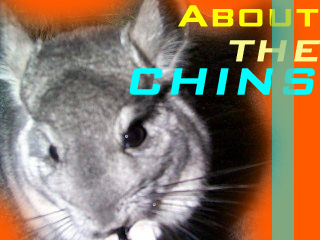The chinchilla's natural habitat is high in
the Andes of Bolivia, Peru, Chile, and Argentina. Classified as members
of the order Rodentia, chinchillas are small rodents related to squirrels,
guinea pigs, mice, hamsters, and gerbils. Chinchillas are the most
expensive of all rodents in the world because their soft fur is the
most sough-after of all skins used in making fur garments (which I
hate grrr).
The two species of chinchillas, Chinchilla
brevicaudata and Chinchilla lanigera, are outwardly almost
indistinguishable. Both species have long hind limbs, short forelimbs,
four toes, and flexible digits (just like the picture to your right).
brevicaudata presents a stockier appearance than lanigera.
It has a thicker neck and shoulders, shorter ears and a flatter
nose than lanigera. It is heavily furred with light gray hair
often tinged with a yellowish hue. lanigera has a sleeker look
because of its narrower neck and shoulders and somewhat more pointed
face and elongated ears. The fur is very silky, usually medium to
dark gray with a bright bluish cast. Only lanigera is commonly
available.
|
 |
|
 Similar
to other rodents such as beavers, hamsters, and guinea pigs, chinchillas
have two continuously growing incisor teeth in the upper jaw and two
in the lower jaw. They are nocturnal animals, being active mostly at
dusk and at night. During daylight hours in the wild, they sleep in
dark hiding places such as holes and crevices. As the sun goes down
they begin to search for food. Similar
to other rodents such as beavers, hamsters, and guinea pigs, chinchillas
have two continuously growing incisor teeth in the upper jaw and two
in the lower jaw. They are nocturnal animals, being active mostly at
dusk and at night. During daylight hours in the wild, they sleep in
dark hiding places such as holes and crevices. As the sun goes down
they begin to search for food.
What sets chinchillas apart from the rest of
the rodents is their fur. It is so silky, dense, light, and soft (kind
of makes you want to cuddle up to one ^^) that it is virtually unmatched
by any other fur-bearing animal.
Both
species were originally brought to the United States to be bred as fur
producers. Since lanigera adapeted better to captivity and reproduced
better, brevicaudata was enentually drooped from most fur-farming
programs. Therefore, it is generally assumed that most of the animals
in North America are lanigera descendants. Culls and other poor
fur specimens became the first chinchillas offered as commercial pets.
Today most pets on the market have been bred for just that purpose.
Brevicaudata and lanigera are now mostly extinct
in their original range. Protected by their governments, chinchillas
cannot legally be hunted or trapped, but the hungry natives still eat
them ( and guinea pigs, too). The wild chinchilla population is on the
U.S. Endangered Species list.
|
|


 Similar
to other rodents such as beavers, hamsters, and guinea pigs, chinchillas
have two continuously growing incisor teeth in the upper jaw and two
in the lower jaw. They are nocturnal animals, being active mostly at
dusk and at night. During daylight hours in the wild, they sleep in
dark hiding places such as holes and crevices. As the sun goes down
they begin to search for food.
Similar
to other rodents such as beavers, hamsters, and guinea pigs, chinchillas
have two continuously growing incisor teeth in the upper jaw and two
in the lower jaw. They are nocturnal animals, being active mostly at
dusk and at night. During daylight hours in the wild, they sleep in
dark hiding places such as holes and crevices. As the sun goes down
they begin to search for food.